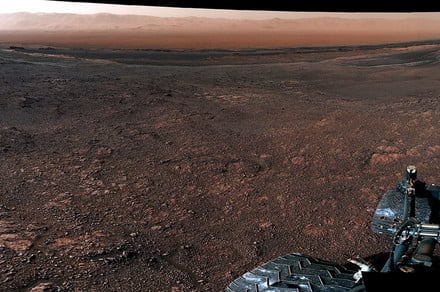The Curiosity rover has been exploring the Vera Rubin Ridge on Mars for more than a year now, and it is time for the explorer to move on to new areas of the planet. But before it departs, Curiosity has captured a 360 video of its final drill site — an area that scientists have nicknamed “Rock Hall.” The video is a composite of images taken in a panoramic form on December 19, 2018, which you can move around to get a feeling of what the view is like from the rover:
[youtube https://www.youtube.com/watch?v=e-gZpz8zuDQ?feature=oembed&w=100&h=100]
If you can’t watch the video, then an image of the panorama is embedded below as well:
This panorama was taken on Dec. 19 (Sol 2265) by the Mast Camera (Mastcam) on NASA’s Curiosity Mars rover. The rover’s last drill location on Vera Rubin Ridge is visible, as well as the clay region it will spend the next year exploring. NASA/JPL-Caltech/MSSS
In both the video and the image, you can see the surface of Mars and the horizon. The images do not capture the rover itself (though Curiosity’s companion InSight has taken a selfie in the past if you want to see that) or the sky, as these are not the focus of Curiosity’s research. Though you can see Curiosity’s drill and features of the terrain like the most recent drilling site, the Rock Hall Drill Hole, as well as the previous Highfield drill site, and the Gale Crater Rim and Floor. You can also see Upper Mount Sharp in the distance and the area where Curiosity will be moving to study next, called the “clay-bearing unit.”
During its time on the Vera Rubin Ridge, Curiosity made some unexpected discoveries about the geology of the area. “We’ve had our fair share of surprises,” Curiosity science team member Abigail Fraeman of NASA’s Jet Propulsion Laboratory in Pasadena, California, said in a statement. “We’re leaving with a different perspective of the ridge than what we had before.” For example, Curiosity confirmed the presence in the bedrock of hematite, an iron-rich mineral which often forms in water, suggesting that in the past there was groundwater on some parts of the ridge.
A crop of the Curiosity’s 360 image, showing the edge of the rover and the Martian surface. NASA/JPL-Caltech/MSSS
The rover is now moving on to a trough between the ridge and the rest of the mountain called Glen Torridon. It is called “clay-bearing” because data from orbiters shows that rocks there contain clay minerals which form in water. Scientists hope to learn more about the ancient lakes that formed in the area by examining the rocks in greater detail.
Editors’ Recommendations
- Curiosity rover learns a new trick: Measuring the gravity of mountains
- Curiosity has found an intriguing shiny object on the surface of Mars
- Ultima Thule’s peculiar shape is a puzzle for scientists
- Say cheese: InSight lander posts a selfie from the surface of Mars
- NASA selects the all-important landing site for its Mars 2020 rover mission

